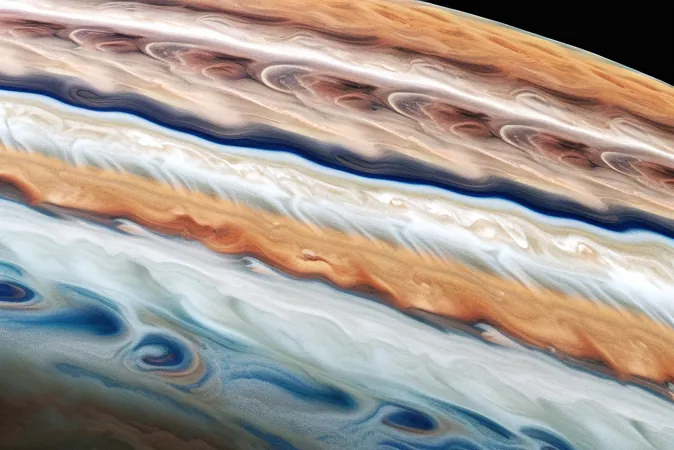
Groundbreaking Discovery about Jupiter's Clouds Leaves Astronomers Baffled!
2025-01-09
Author: Ming
Groundbreaking Discovery about Jupiter's Clouds Leaves Astronomers Baffled!
Jupiter has long captivated the imagination of astronomers and stargazers alike, with its striking bands of clouds and its monumental Great Red Spot. However, new research from a team of adventurous citizen scientists has upended existing theories about the formation of Jupiter's visible clouds, revealing that they are not primarily composed of ammonia ice as previously believed.
This significant revelation sheds new light on the intricate dynamics of Jupiter’s cloud layers and was recently published in the Journal of Geophysical Research – Planets. For decades, astronomy enthusiasts have meticulously tracked Jupiter, documenting its constantly changing features, including dramatic storms and swirling vortexes, yet the actual composition of its most prominent cloud layers remained shrouded in mystery.
A New Wave of Observation
The breakthrough originated from amateur astronomer Dr. Steven Hill in Colorado, who utilized commercially available telescopes and specialized color filters to examine Jupiter’s atmosphere. Capturing images at specific wavelengths, Dr. Hill measured ammonia levels and the height of cloud tops. Intriguingly, his findings suggested that the clouds reside at depths too warm for ammonia ice to exist — a startling revelation for the scientific community.
Following Dr. Hill's observations, Professor Patrick Irwin from the University of Oxford collaborated with his research team to validate these results by applying Dr. Hill's method to data obtained from the Multi Unit Spectroscopic Explorer at the European Southern Observatory in Chile. Their advanced simulations indicated that the primary cloud layers are indeed situated deeper than previously anticipated and are unlikely to be solely composed of ammonia ice.
“I am astonished that such a simple method is able to probe so deep into the atmosphere and demonstrate clearly that the main clouds cannot be pure ammonia ice!” exclaimed Professor Irwin. Dr. Hill’s accessible techniques have opened up new avenues for understanding the complex nature of Jupiter's clouds, making it possible for citizen scientists to contribute meaningfully to ongoing research.
The Role of Citizen Science
Dr. Hill’s ambitious approach has resulted in newfound insights into Jupiter’s weather patterns. By analyzing subtle variations in brightness through narrow color filters, he produced ammonia maps more affordably than traditional complex models could achieve. This democratization of scientific inquiry allows amateur astronomers to keep an eye on atmospheric shifts, tracking events like the appearance of minor storms and alterations surrounding Jupiter’s striking bands.
“Often, my goal is to see how far I can push my observations with modest equipment, and I never anticipated this level of success,” said Dr. Hill.
Notably, while ammonia-rich clouds can occasionally form from strong updrafts, spacecraft like NASA's Galileo and Juno have documented small pockets of ammonia ice floating within Jupiter’s darker cloud decks, providing further evidence and exciting prospects for future research.
A Broader Perspective: Connections with Saturn
Inspired by their findings on Jupiter, Professor Irwin's team expanded their analysis to Saturn, employing similar filter-based techniques. Remarkably, these investigations suggested that Saturn's clouds might similarly be situated deeper than the ammonia condensation level, hinting at underlying chemical reactions and complex weather systems in both gas giants.
The overarching similarities between Jupiter and Saturn could reveal essential connections about their atmospheric dynamics, as both planets showcase layered atmospheres sculpted by rising and sinking air currents influenced by solar radiation.
Why This Matters for Future Research
These fresh insights pave the way for more regular and precise observations of Jupiter’s atmosphere. The accessibility of this simpler methodology equips both amateur and professional astronomers with a powerful new tool for monitoring weather patterns and gas distributions in a timely manner. This could significantly enhance our understanding of how atmospheric phenomena such as storms and jets evolve over extended periods.
As researchers continue their quest to map cloud levels and chemical compositions in both Jupiter and Saturn, they aspire to see if these findings align with data gathered from orbiting spacecraft. The synergy of Earth-based observations and space-borne instruments, bolstered by citizen science, promises to deepen our understanding of these dynamic and swirling worlds.
Stay tuned for the latest discoveries in the celestial realms, as the mysteries of our solar system continue to unfurl!


 Brasil (PT)
Brasil (PT)
 Canada (EN)
Canada (EN)
 Chile (ES)
Chile (ES)
 Česko (CS)
Česko (CS)
 대한민국 (KO)
대한민국 (KO)
 España (ES)
España (ES)
 France (FR)
France (FR)
 Hong Kong (EN)
Hong Kong (EN)
 Italia (IT)
Italia (IT)
 日本 (JA)
日本 (JA)
 Magyarország (HU)
Magyarország (HU)
 Norge (NO)
Norge (NO)
 Polska (PL)
Polska (PL)
 Schweiz (DE)
Schweiz (DE)
 Singapore (EN)
Singapore (EN)
 Sverige (SV)
Sverige (SV)
 Suomi (FI)
Suomi (FI)
 Türkiye (TR)
Türkiye (TR)
 الإمارات العربية المتحدة (AR)
الإمارات العربية المتحدة (AR)